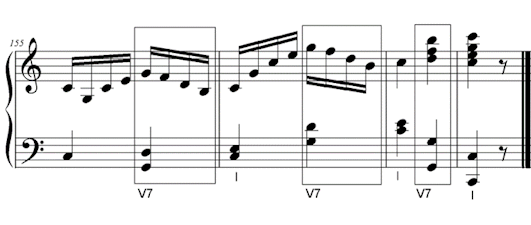Chord V7 – Dominant 7th
The dominant chord (V) was introduced at grade 5. Chord V7 is also known as the “dominant 7th” chord. It is built from the dominant triad, plus another third added on top: the 5th, 7th, 2nd and 4th notes of the scale.
In C major, the dominant 7th chord contains the notes G, B, D and F.

In minor keys, the dominant 7th is built from the harmonic minor scale.
In A minor, the dominant 7th chord contains the notes E, G#, B and D.

Dominant 7ths are useful chords because they each only belong to one pair of keys, unlike triads, which can belong to several different keys. For this reason, chord V7 can help you to work out musical keys more easily. The pair of keys which a V7 chord belongs to is always the major and minor key a perfect 5th lower.
For example, the chord of G7 belongs to the keys of C major and C minor (C is a perfect 5th lower than G). It does not belong to any other key.
Dominant 7th chords are also quite easy to spot, because they have a unique shape. They are the only chords which contain a major triad, plus a minor 7th between the root and 7th. If you see a four-note chord built in this way, then it must be a V7 chord.

V7 usually moves to chord I. Here is the end of the third movement of Mozart’s piano sonata no.1, K279, in C major. The dominant 7th contains the notes G, B, D and F. There are several chord V7s, each moving on to chord I.
